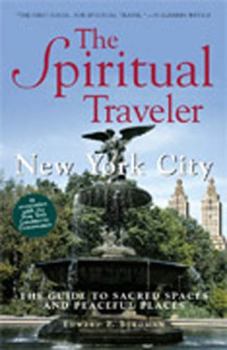New York City: The Guide to Sacred Spaces and Peaceful Places
The Spiritual Traveler: New York City is a unique guidebook. It invites you to discover and explore a multitude of spiritual sites in all five boroughs where New Yorkers have sought peace and strength in the past and in the present. It covers all of the world's religions and spiritual movements, and is written for readers and seekers of every faith and none. The Spiritual Traveler: New York City introduces hundreds of churches, synagogues, mosques,...
Format:Paperback
Language:English
ISBN:1587680033
ISBN13:9781587680038
Release Date:July 2001
Publisher:HiddenSpring
Length:400 Pages
Weight:1.20 lbs.
Dimensions:1.7" x 5.3" x 8.2"
Customer Reviews
3 ratings
splendid read
Published by Thriftbooks.com User , 14 years ago
This is a great read for those who are interested in the religious buildings of New York! Full of historical facts and little known tidbits as well as detailed information on what to look for in each building. Very easy to read and just enough information to keep the interest up and perhaps whet the appetite to do your own exploring to see what else you can uncover. A treat
A Must Read for Every Astute New Yorker or pilgrim
Published by Thriftbooks.com User , 22 years ago
NYC has about 13 retreats, 471 Baptist, 403 Catholic, 437 Jewish, 391 Pentecostal, 163 Episcopalian, 60 Islamic and 1 Bahai religious centers (to name but a few). The book's author, Edward F. Bergman is chairman of geographic studies at CUNY's Lehman College. The book is the must read for astute New Yorkers and tourists. It is eminently enlightening about the city's history, its architecture and its religious progression. As Bergman writes, from the early 17th Century, the chief religion of the non-Native Americans of the New Netherlands was the (Dutch) Reformed Church of Protestants, which spawned the Collegiate system of churches (read it and you will discover why they are called Collegiate Churches). As new settlers arrived, and New Amsterdam became British, new churches were established, persecuted, tolerated, and then in most cases, accepted. In the first chapter, Bergman includes brief histories for the major NYC religions, including Quaker, Adventist, and Sikh. In the second chapter, he discusses the architectural elements found in houses of worship and their origins. The styles explained include that of the basilica, cruciform with transepts, Gothic nave, Greek cross, and narthexporch, as well as those of Wren-Gibbs, Georgian, Greek Revival, Gothic Revival, High Victorian Gothic, Gothic, Romanesque Revival, and Renaissance Revival. He explains why some Protestant churches did away with their stained glass windows. The reader will also learn about the mihrab of a mosque, the Sikh gurdwara, and the Hindu rajagopuram, and along the way learn about religious history and the lives of saints and other clerics. In Chapters 3 through 9, Bergman describes the houses of worship by neighborhood. In Chapter 3, for example, the buildings of Downtown Manhattan are discussed. For each worship location, the address and architect are listed. For Trinity Church there are four pages of history; the African Burial Ground is discussed in three, as is the Eldridge Street Synagogue. Did you know that you can find the largest Buddha in the area at Mahayara, that the Sung Tak Buddhist Temple was formerly a Kalwarie shul, The Middle Reformed Coll. Church has its own Liberty Bell dating to 1729, or that the Beth Hamedrash Hagadol (1885) was the seat of NYC's short-lived Chief Rabbi in 1899? The book answers why the German Catholic Church of the Most Holy Redeemer is built so high, and why J.P Morgan supported St George's Episcopal Church to the extent he did. Every few pages there is a shaded section that explains a topic, such as "the Greek Temple style in NYC"; "The Influence of the Reverend George Whitefield in the early 18th Century"; "the Jesuit Teilhard de Chardin and his noospere"; "The Draft Riot of 1863"; "Fulton Sheen and his ratings war with Milton Berle"; and "Churches and Multipurpose Buildings." Bergman also includes an "Around the Corner" paragraph after several listings to point out other attractions, like the harrowing offshore M
A travel, historical and architectural guide to NYC
Published by Thriftbooks.com User , 22 years ago
"The Spiritual Traveler New York City" is more than just a guide to a few churches in NYC. It includes wonderful historical and architectural information on all the great houses of worship in the 5 boroughs of NYC as well as hidden jewels and oases of peace and calm that have been the prized secrets of many New Yorkers for years. While there is detailed information about churches of all denominations, synagogues, mosques and Hindu and Buddhist temples, it is all presented in a way that people who are not familiar with a lot of technical terms can understand and explanations are always provided. It's also compact enough that it easily fits into a backpack or pocketbook. I think "The Spiritual Traveler New York City" is not only perfect for tourists that want to know a little bit more about the spiritual history of NYC and about some of it's well-known places of worship, but is also perfect for the person (even New Yorkers like me)who wants the inside scoop on where to find peace and tranquility in the sea of madness that is NYC!! For those of you who like this book and are planning a trip to England, "The Spiritual Traveler England Scotland and Wales" is also available and is another great travel guide.




